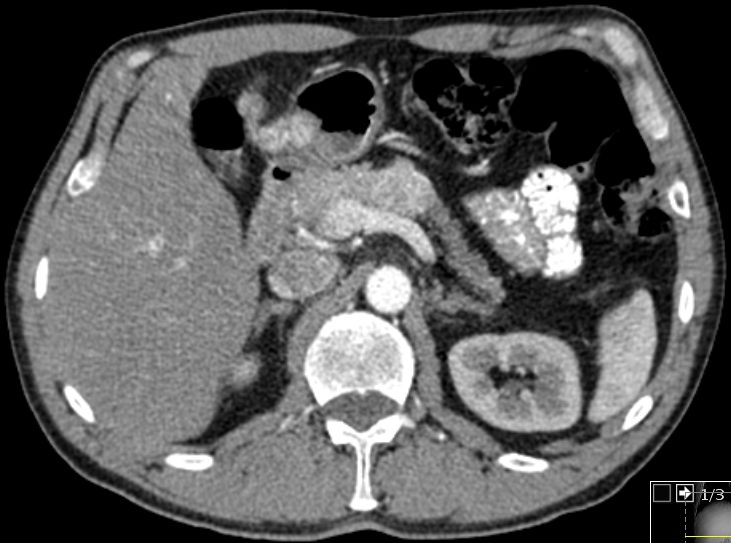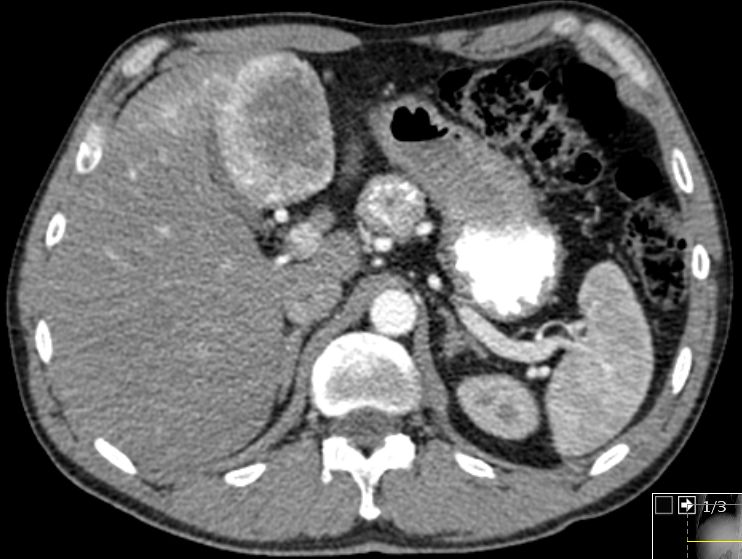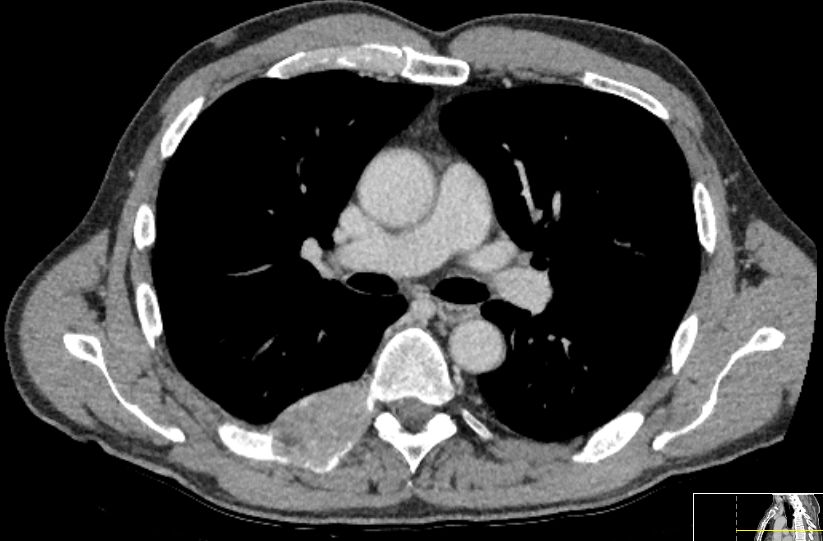zurück
Home |
Pankreatische neuroendokrine Tumoren (NET, PNET) |
| Allgemeines |
Neuroendokrine Tumoren gibt es in verschiedenen Körperteilen. Am
häufigsten sind gastrointestinale NET. |
| NF-PNET |
non-funktionale neuroendokrine Tumoren des Pankreas |
70–90% aller PNET
5‑a OS: 30-66% |
| funktionale |
funktionale pankreatische,
neuroendokrine Tumoren 10- 30%. |
Sekretion verschiedener Hormone
z.B. Insulin, Gastrin. Hormone - Excess - Syndrome führten meistens zum Tode. |
| Insulinom |
Sekretion von Insulin, Gastrin. Selten maligne. |
Hypoglykämie, Katecholamin - Ausschüttung |
| Gastrinom |
Sekretion von Gastrin. |
Rezidivierende peptische Ulzera,
Diarrhö, Steatorrhoe . |
| Glugagonom |
Sekretion von Glukagon. |
Diabetes, migratorisches,
nekrolytisches Erythem, Gewichtsverlust, Thromboembolie, Pahypoaminoacidurie |
| VIPom |
Sekretion von VIP (vasoaktives intestinales
Peptid). |
Wässrige Diarrhö, Hypokaliaemie,
Achlorhydie, metabolische Azidose, Hyperglykämie, Flush, Hyperkalzämie |
| Somatostatinom |
Sekretion von Somatostatin |
Diabetes, Diarrhö, Steatorrhoe,
Hypochlorhydrie, Gewichtsverlust, Gallenblasenerkrankung |
| pankreatisches Polypeptidom |
Sekretion von pankreatischen Polypeptiden |
Hepatomegalie, Bauchschmerzen,
wässrige Diarrhö |
| Epidemiologie |
Inzidenz 3-5 / 100.000 EW * a. 1,3% aller
Pankreastumoren. Inzidenz ansteigend. >50% primär M1 |
| Prognose |
>50% maligne. M1: 5a-survival 30-40% |
| Diagnostik |
54-jähriger Mann mit einem Pankreaskorpus-NED mit
Lymphknoten- und Lebermetastasen. Das CT zeigt eine kontrastmittelaufnehmende
Raumforderung im Pankreaskorpus von 4 cm Durchmesser mit einzelnen Verkalkungen
und zentral einem hypodensen Areal.
 |
Intrahepatisch Nachweis mehrerer, insbesondere in
der arteriellen Phase stark Kontrastmittel aufnehmender tumoröser
Raumforderungen. Lymphknotenmetastase hinter der Magenwand.
 |
8 Jahre später: Nach zahlreichen Operationen,
interstitieller Brachytherapie z.Z. intraabdominaler Tumor beherrscht. Jetzt
Metastase am Ansatz der 7. Rippe rechts mit drohendem Einbruch in den
Spinalkanal.
 |
| Grading |
Ki67 > 20%: G3 |
| Chemotherapie |
objektive Response - Rate: 10-45% |
| Somatostatin - Analoga |
Octreotid LAR kann das progressionsfreie Überleben bei limitiert metastasiertem
Tumor verlängern. |
| Sunitinib |
Eine Studie mit 171 Patienten prüfte 37,5mg
Sunitinib gegen Placebo(10). Das PFS verbesserte sich von 5,5 auf 11,4 Monate.
Response-Rate 9,3% |
| Studien |
ECOG-ACRIN E2211: Temozolomide or Temozolomide and Capecitabine, Advanced Pancreatic Neuroendocrine Tumors |
RADIANT: Envirolismus beim
metastasierten, chemotherapieresistenten, pankreatischen NET |
Quellen |
1.) Metz DC, Jensen RT:
Gastrointestinal neuroendocrine tumors: pancreatic endocrine tumors.
Gastroenterology 135(2008):1469-1492
2.) Panzuto F, Nasoni S, Falconi M, et al.:
Prognostic factors and survival in endocrine tumor patients: comparison between
gastrointestinal and pancreatic localization.
Endocr Relat Cancer 12(2005):1083-1092
3.) Hauso O, Gustafsson BI, Kidd M, et al.:
Neuroendocrine tumor epidemiology: contrasting Norway and North America.
Cancer 113(2008):2655-2664
4.) Modlin IM, Oberg K, Chung DC, et al.:
Gastroenteropancreatic neuroendocrine tumours.
Lancet Oncol 9(2008):61-72
5.) Zhou J, Enewold L, Stojadinovic A, et al.:
Incidence rates of exocrine and endocrine pancreatic cancers in the United
States.
Cancer Causes Control 21(2010):853-861
6.) Rinke A, Muller HH, Schade-Brittinger C, et al.:
Placebo-controlled, double-blind, prospective, randomized study on the effect of
octreotide LAR in the control of tumor growth in patients with metastatic
neuroendocrine midgut tumors: a report from the PROMID Study Group.
JCO 27(2009):4656-4663
7.) Duerr EM, Chung DC:
Molecular genetics of neuroendocrine tumors.
Best Pract Res Clin Endocrinol Metab 21(2007):1-14
8.) Yao JC, Shah MH, Ito T, et al.:
Everolimus for advanced pancreatic neuroendocrine tumors.
NEJM 364(2011):514-523
9.) Missiaglia E, Dalai I, Barbi S, et al.:
Pancreatic endocrine tumors: expression profiling evidences a role for AKT-mTOR
pathway.
JCO 28(2010):245-255
10.) Raymond E, Dahan L, Raoul J-L, et al.:
Sunitinib malate for the treatment of pancreatic neuroendocrine tumors.
NEJM 364(2011):501-513
|
 |
Teil von |
Pankreas - Karzinom |
Gastro - Intestinale Tumore |



